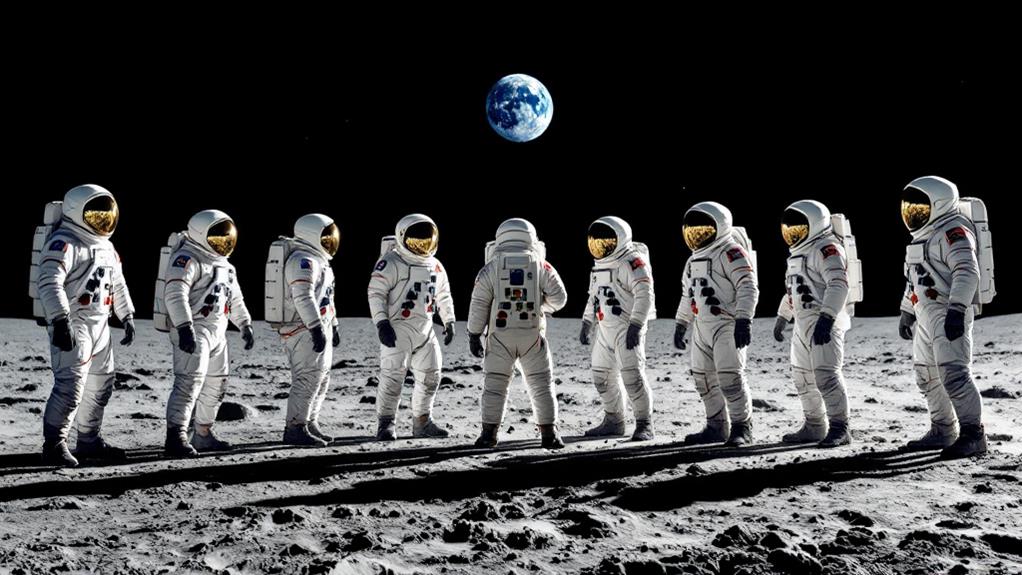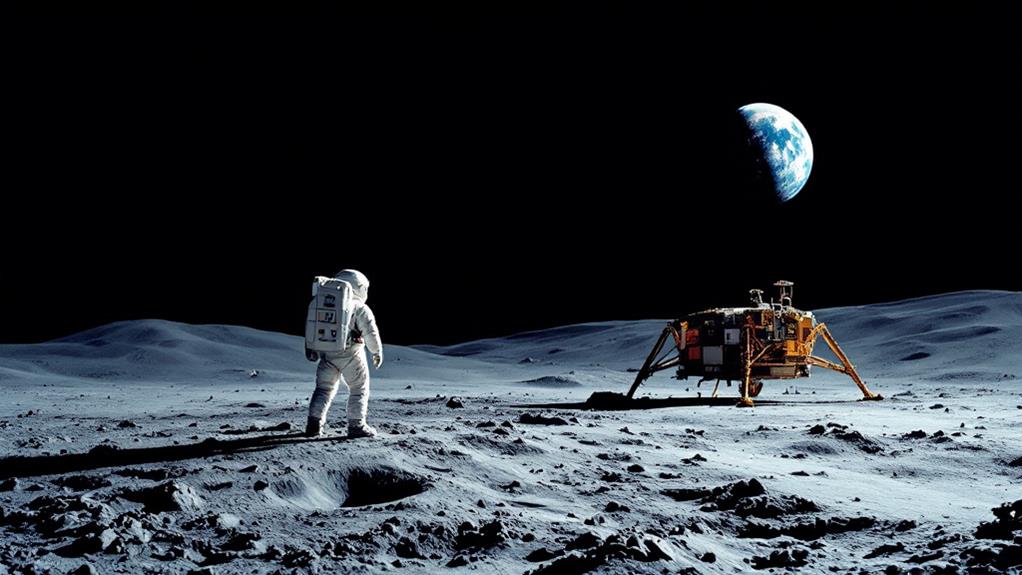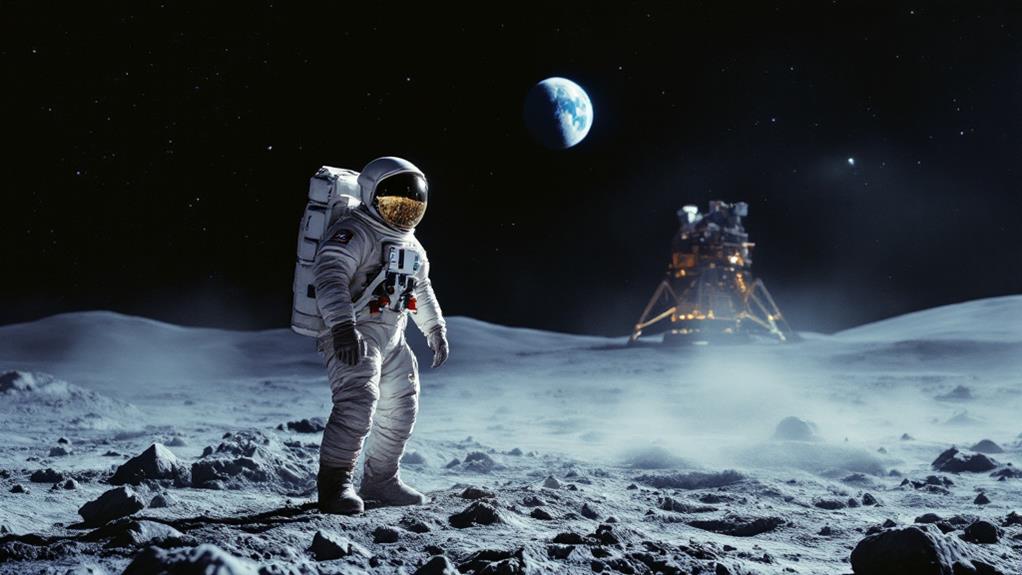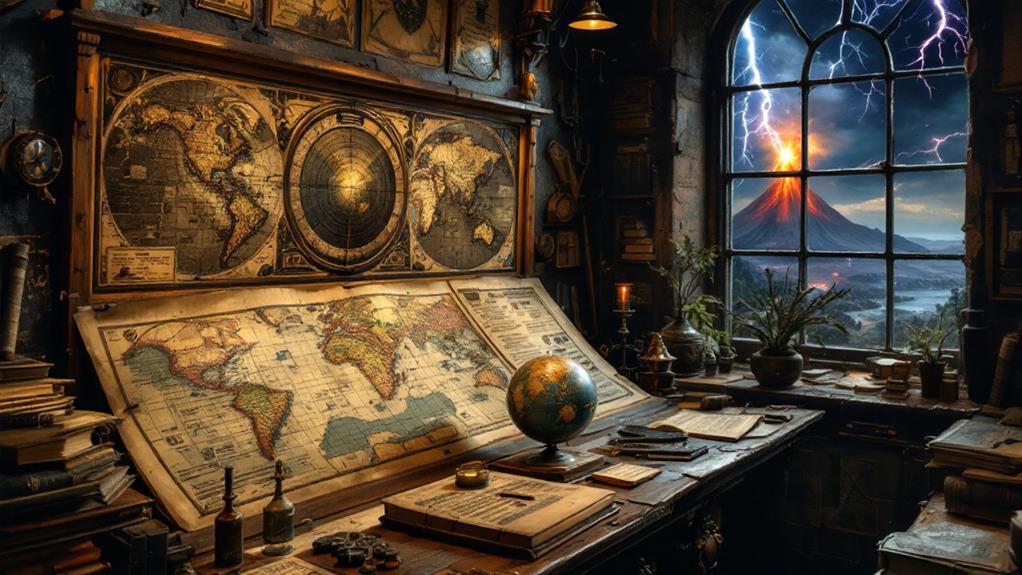The Twelve Men Who Walked on the Moon: Their Stories and Legacy

You're about to investigate the incredible odysseys of the twelve men who left footprints on the Moon's surface. From Neil Armstrong's iconic "one giant leap for mankind" to Buzz Aldrin's "magnificent desolation," their missions forever changed our understanding of space. Alan Bean painted the Moon's beauty, while Edgar Mitchell's lunar experience sparked insights into human consciousness. John Young showcased unmatched versatility across six missions, and Eugene Cernan's leadership on the final Apollo mission left a lasting impression. Each of these pioneers contributed distinctively to space exploration, offering inspiration and insight that still captivate and inform you today. Uncover more.
Neil Armstrong's Historic Steps
On that momentous day, with anticipation and awe, Neil Armstrong became the initial human to set foot on the lunar surface. As you imagine the scene, think about the immense significance of the moon landing. It wasn't just a step for Armstrong; it was a giant leap for mankind. The world watched as he delivered those famous words: "That's one small step for man, one giant leap for mankind." This moment symbolized human perseverance and sparked a new chapter of lunar exploration advancements.
As you consider the moon landing's significance, reflect on how it reshaped our understanding of what's possible. The Apollo 11 mission opened doors to further lunar exploration, encouraging scientists and engineers to push the boundaries of space travel. It laid the groundwork for future missions, enabling us to study the moon's surface and composition more deeply. This achievement inspired generations to pursue careers in STEM fields, fueling innovation and exploration.
Buzz Aldrin's Moonwalk Experience
As Neil Armstrong's historic words echoed across the globe, Buzz Aldrin prepared to join him on the lunar surface. You can imagine the anticipation coursing through him as he descended the ladder of the lunar module, becoming the second human to walk on the Moon. Aldrin's reflections on that moment reveal a mixture of awe and profound contemplation. He described the lunar landscape as "magnificent desolation," a stark contrast to the lively Earth he'd left behind.
Once on the Moon, Aldrin relished the unique experience. He famously practiced his "lunar Olympics," experimenting with different ways of moving in the Moon's low gravity, which offered a fascinating insight into human adaptability. His efforts contributed considerably to the mission's success, proving that humans could work effectively on another celestial body.
Aldrin's lunar legacy extends beyond his own experiences; it serves as a powerful reminder of human curiosity and discovery. His reflections continue to inspire generations, urging them to push beyond their limits and investigate the unknown. As you reflect on Buzz Aldrin's moonwalk experience, consider how it symbolizes humanity's enduring quest for knowledge and adventure in the vast universe.
Alan Bean's Lunar Adventure

During Alan Bean's lunar adventure, he carved his own unique path into the history of space discovery. As the fourth person to set foot on the Moon, you can imagine the thrill Bean felt, standing on the lunar surface during the Apollo 12 mission. Unlike others, though, Bean's legacy extended beyond scientific achievements. He combined his passion for space and art, creating a remarkable lunar legacy through his artistic expression.
Once back on Earth, Bean translated his lunar experiences into enchanting paintings. He used actual moon dust and pieces of spacecraft to add authenticity to his work. When you see his art, you don't just view a depiction; you feel the Moon's mysterious allure and the excitement of adventure. Alan Bean's paintings offer a vivid narrative of his odyssey, blending his technical understanding with an artist's eye.
His ability to capture the spirit of lunar exploration guarantees that his contributions resonate with future generations. By merging science and art, Bean's work serves as a powerful reminder of the human endeavor to investigate beyond our world. Through his artistic legacy, you're inspired to appreciate the beauty and wonder of the Moon.
Edgar Mitchell's Cosmic Insights
For Edgar Mitchell, walking on the Moon was more than a scientific milestone; it sparked a profound shift in his understanding of the universe. As you investigate his expedition, you'll uncover that his Apollo 14 mission not only advanced space exploration but also transformed his worldview. Mitchell experienced what he described as an "epiphany" while gazing at Earth from the lunar surface. This profound moment led him to a concept he called cosmic consciousness, a belief in the interconnectedness of all life and the universe's vast mysteries.
He returned to Earth with a mission beyond scientific revelation. You'd find it fascinating how Mitchell dedicated the rest of his life to examining the frontiers of human consciousness. He founded the Institute of Noetic Sciences, aiming to bridge the gap between science and spirituality. His insights challenged conventional thinking, encouraging you to ponder the universe's deeper meanings.
Mitchell's cosmic consciousness didn't just inspire philosophers and scientists; it invited everyone to reflect on humanity's role in the cosmos. His lunar experience reminds you that space exploration can lead to unexpected revelations, transforming our understanding of existence itself.
John Young's Space Journeys

John Young's remarkable space endeavors illustrate the courage and innovation that defined the Apollo period. As you investigate Young's achievements, you'll notice his unique contributions to space exploration. He was one of the few astronauts who flew both the Gemini and Apollo missions, showcasing versatility and adaptability. Young's expedition with Gemini 3 marked the initial manned flight of the program, displaying his pioneering spirit. But it was his role as the commander of Apollo 16 that truly cemented his legacy. During this mission, Young and Charles Duke spent nearly three days on the lunar surface, conducting experiments and collecting samples that expanded our understanding of the Moon.
Young's legacy extends beyond his lunar landings. He was the initial astronaut to fly six space missions, including two to the Moon. His fearless approach to problem-solving, combined with his technical expertise, helped push the boundaries of human spaceflight. By leading the Space Shuttle Columbia's maiden flight, Young demonstrated his unwavering commitment to advancing space exploration. As you reflect on John Young's space expeditions, you'll appreciate the indelible mark he left on humanity's quest to investigate the unknown, making him a true pioneer in the annals of space history.
Eugene Cernan's Lasting Impact
As you investigate Eugene Cernan's contributions to space exploration, you'll find a legacy defined by courage and discovery at its finest. Cernan's leadership was instrumental during the Apollo 17 mission, where he served as the commander. This mission marked not only his second trip to the lunar surface but also the last time humans set foot on the Moon. His ability to inspire and lead his crew was crucial in ensuring the mission's success and safety, showcasing his exceptional skills as an astronaut.
Cernan's lunar legacy extends beyond his footprints on the Moon's dusty surface. He passionately advocated for continued space exploration long after his retirement. By sharing his experiences and emphasizing the importance of pushing beyond our earthly bounds, Cernan ignited a spark in future generations of explorers. His commitment to discovery and education has left an indelible mark on the field of space travel.
Through Cernan's leadership and enduring lunar legacy, you can see the profound impact one individual can have on humanity's understanding of space. His dedication to discovery serves as a powerful reminder of the possibilities that await when we dare to dream and reach for the stars.



